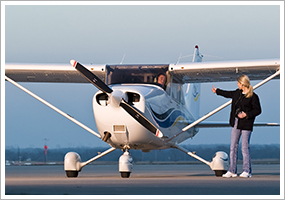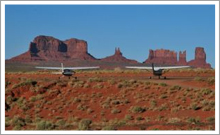June 18, 2010, issue of 'AOPA ePilot - Flight Training Edition' e-newsletter
| ||||
| | FT News | INSIDE AOPA | TRAINING PRODUCTS | FINAL EXAM | |||
TRAINING TIPsMany meanings of ‘solo’
Take “solo.” To most student pilots, it’s obvious that solo refers to the time when they fly the aircraft alone. However there have been cases (and accidents) in which student pilots espoused the incorrect idea that someone such as a friend who was a certificated pilot could accompany them on solo flights. Not so! “From a legal standpoint, Federal Aviation Regulation 61.87 says that the term ‘solo flight as used in this subpart means that flight time during which a student pilot is the sole occupant of the aircraft.’ A common industry definition says ‘solo’ is any flight time during which the pilot is the only occupant on board,” states the Flight Training website’s Pre-Solo FAQ page.
Compliance with a flight instructor’s logbook endorsements and limitations is another responsibility of the soloing student pilot. But the instructor’s supervisory role is also tightly defined; you, the student, should never feel that you have been left alone to decide whether to make a flight. Compare your procedures with the case of a cross-country flight described in the February 2003 Flight Training “Legal Briefing” column.
A student pilot is subject to specially prescribed operational guidelines under visual flight rules. One such condition is the requirement that the flight always have visual reference to the surface. Kathy Yodice elaborated on this idea in the November 2009 Flight Training: “Thus, flying over a ‘cloud deck,’ even if it is not a solid deck of clouds but scattered or broken, and even if it is only for a limited time during an otherwise beautiful VFR flight, is not allowed for student pilots since doing so inhibits the student’s ability to see the ground.” Was that your understanding?
Despite curtailments, there is recognition that you are commander of your aircraft when soloing. Meet that challenge by training with the solo courses and quizzes offered by the AOPA Air Safety Foundation. Act in the name of safety, and your decisions will always reflect your best judgment. YOUR PARTNER IN TRAININGEvery student pilot has questions. Probably lots and lots of questions. Luckily, there are resources to turn to. AOPA’s Pilot Information Center, a staff of flight instructors and pilots trained to handle your questions, is available every weekday from 8:30 a.m. to 6 p.m. Eastern time. This highly trained group of individuals has more than 30,000 collective flight hours, including time as flight instructors, airline pilots, and more. Call them today (800/USA-AOPA) for any aviation-related questions you may have.
Did you know that student pilots who join AOPA are three times more likely to complete their flight training? Membership includes unlimited access to aviation information by phone (800/USA-AOPA, weekdays from 8:30 a.m. to 6 p.m. Eastern time) or from AOPA Flight Training Online or AOPA Online. If you're not already a member, join today and get the pilot's edge. Login information is available online. FLIGHT TRAINING NEWS‘Wow, I just did that!’: New pilot, student open airshowAfter watching the aerial stunts of aerobatic pilots at the OC Air Show in Ocean City, Md., for the past couple of years, two spectators landed the best seat for this year’s show—the left seat. Chelsea Remines, a 23-year-old who earned her private pilot certificate April 2, and 15-year-old student pilot Jessica Galuardi soared along the shoreline at a few hundred feet with their flight instructors in a Cessna 172 to open the show on June 5 and 6. More than 300,000 people lined the beach, cheering for the young women each day they flew along the shore. Read more >> Balloon Federation of America offers summer campsStudents ages 13 to 18 can get a taste of the lighter side of aviation this summer. The Balloon Federation of America is hosting summer camps in Michigan and Massachusetts. During the camps, students will learn about topics including balloon systems, weather, crew safety, ballooning rules and regulations, and more. The camp also will include hands-on activities for the students like balloon tethers, according to the website. Read more >> Thunderstorms: Don’t let summer’s beasts get the best of youToo often, pilots find themselves caught in thunderstorms. Learn how to steer clear in the AOPA Air Safety Foundation’s newly revised Weather Wise: Thunderstorms & ATC online course—which includes a flight simulator re-creation, with actual ATC audio, of a thunderstorm incident over south Florida. To find out even more about ATC radar limitations, making the system work better for you, and essential communications to help you avoid these deadly hazards, join AOPA Air Safety Foundation President Bruce Landsberg and air traffic controllers in a live Webinar, “Thunderstorms & ATC: What You Need To Know,” Wednesday, June 30, at 3 and 7 p.m. Eastern time. Register online >> School briefs
Inside AOPABring a guest to AOPA Aviation SummitThis year AOPA is hosting Aviation Summit in sunny Long Beach, Calif. With exciting forums, captivating speakers, and the latest and greatest in aviation technology on display, attending Summit is a natural for any pilot. But it’s not only pilots who should attend. Summit offers a variety of entertaining events that are fun for the whole family, including Airportfest and social events such as a Friday Night Block Party, an AOPA Foundation event aboard the Queen Mary, and exclusive Thursday night dinners with aviation celebrities. Read more >> Fit to flyWe all know that lovely feeling—and it never gets old, unlike us. We wake up and peer out the window, and the blue sky beckons. We check the weather: good to go. We check the notams and so on—no problem. Then we head to the airport to check the airplane. But what about ensuring we are fit to fly? First, we should add ourselves to the preflight checklist. Find out more about how to take preventive action in this selection from the AOPA Medical Services Program newsletter. AOPA members enrolled in the Medical Services Program get tips like these—and more—bimonthly. Demand for AOPA Airports online grows, book still availableEverything AOPA is hearing from pilots—members and nonmembers alike—is that the recently redesigned AOPA Airports online airport directory is increasingly one of their main sources of airport information. Due to the declining interest in the print edition and the costs associated with printing, there will be a change to this year’s book. The next print edition, which will be available for pre-order near the end of June, will be offered to nonmembers for $39.95, and to members for a discounted price of $19.95. Read more >> TRAINING PRODUCTSWingX on the iPadThe iPad is already revolutionizing aviation applications with the ability to cheaply and easily carry a full flight planning suite, moving maps, and approach charts anywhere you go. WingX is a pioneer in aviation applications, and its new iPad app features terrain-enhanced moving maps, a flight planning interface for CSC DUATS, and approach charts. The application is $99 from the Apple store.
Note: Products listed have not been evaluated by ePilot editors unless otherwise noted. AOPA assumes no responsibility for products or services listed or for claims or actions by manufacturers or vendors. FINAL EXAMQuestion: I sometimes get confused by the different classifications of airspace. Can you explain to me the different types of airspace?
Answer: There are basically two kinds of airspace: controlled and uncontrolled. Class A, B, C, D, and E airspace are all considered to be controlled airspace, which is “airspace of defined dimensions within which air traffic control service is provided to IFR flights and to VFR flights in accordance with the airspace classification.” Class G airspace is any airspace not designated as A, B, C, D, or E, and is defined as uncontrolled airspace. There are various regulatory requirements for operations within each of these airspace classifications. For detailed information, see the AOPA Air Safety Foundation’s Airspace for Everyone Safety Advisor and the Flight Training article, “Airspace ABCs.”
Got a question for our technical services staff? E-mail [email protected] or call the Pilot Information Center, 800/872-2672. Don’t forget the online archive of “Final Exam” questions and answers, searchable by keyword or topic. what’s new onlineShow me the moneyAirline pilot pay is a complex web of schedule, benefits, and hours. Airline pilot Chip Wright decodes the process this week on the Flight Training blog. Wright explains that the process isn’t just about taking the number of flight hours and multiplying it by a dollar amount. Read the post to learn more. Picture Perfect
AVIATION EVENTS & WEATHER To include an event or to search all events in the calendar, visit AOPA Online. For airport details, including FBO fuel prices, see AOPA Airports. Flight Instructor Refresher ClinicsThe next AOPA Air Safety Foundation Flight Instructor Refresher Clinics are scheduled in San Jose, Calif., and Charlotte, N.C., June 26 and 27; Memphis, Tenn., July 10 and 11; Jacksonville, Fla., and Newark, N.J., July 17 and 18; Pittsburgh, Pa., July 24 and 25; Atlanta, Ga., and Fort Worth, Texas, Aug. 7 and 8; Champaign, Ill., Aug. 14 and 15; Costa Mesa, Calif., and Reno, Nev., Aug. 21 and 22; Allentown, Pa., Aug. 28 and 29. For a complete schedule, see AOPA Online.
Can’t make it in person? Sign up for the CFI Refresher Online. AOPA Air Safety Foundation Safety SeminarsAOPA Air Safety Foundation Safety Seminars are scheduled in Oshkosh, Wis., July 28, 29 and 30; Germantown, Tenn., Aug. 30; Nashville, Tenn., Aug. 31; and Maryville, Tenn., Sept. 1. Topics vary—for details and a complete schedule, see AOPA Online. | Advertisers Got news? Contact ePilot. Having difficulty using this service? Visit the ePilot Frequently Asked Questions now at AOPA Online or write to [email protected]. |
| Member Tools : Send feedback | Update member profile | Change email address | Unsubscribe | ePilot Archive Editorial Team: ePilot Flight Training Editor : Ian Twombly | ePilot Editor: Sarah Brown | Contributor: Alton Marsh |

 The June 11, 2010, “
The June 11, 2010, “ 

